Thomas Johnson was born in Selby in the early 17th century. A ‘learned, amiable, brave man’, he was a leading herbalist of his day, recording many examples of the giant bellflower found on the banks of the River Ouse which flows through Selby. Johnson combined his work as an apothecary with botanical excursions around England and Wales, publishing many books about his discoveries. He later fought for the Royalists in the Civil War and was ‘mortally wounded’.
Illustrations and text about Selby Abbey.
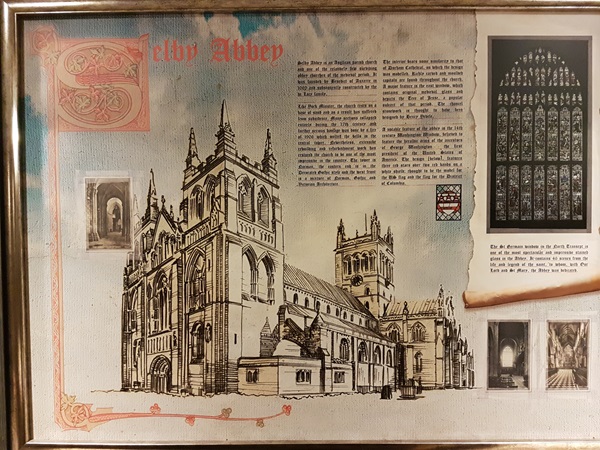
The text reads: Selby Abbey is an Anglican parish church and one of the relatively few surviving abbey churches of the medieval period. It was founded by Benedict of Auxerre in 1068 and subsequently constructed by the de Lacy family.
Like Dork Minster, the church rests on a base of sand and as a result has suffered from subsidence. Many sections collapsed entirely during the 17th century and further serious damage was done by a fire of 1906 which melted the bells in the central tower. Nevertheless, extensive rebuilding and refurbishment work has restored the church to be one of the most impressive in the country. The tower is Norman, the eastern end is in the Decorated Gothic style and the west front is a mixture of Norman, Gothic and Victorian Architecture.
The interior bears some similarity to that of Durham Cathedral, on which the design was modelled. Richly carved and moulded capitals are found throughout the church. A major feature is the east window, which contains original medieval glass and depicts the Tree of Jesse, a popular subject of that period. The chancel stonework is thought to have been designed by Henry Debele.
A notable feature of the abbey is the 15th century Washington Window, believed to feature in the heraldic arms of the ancestors of George Washington – the first president of the United States of America. The design (below), features three red stars over two red bands on a white shield; thought to be the model for the US flag and the flag for the District of Columbia.
The St Germain window in the North Transept is one of the most spectacular and impressive stained glass in the abbey. It contains 46 scenes from the life and legend of the saint, to whom, with Our Lord and St Mary, the abbey was dedicated.
Illustrations and text about the Giant Bellflower.
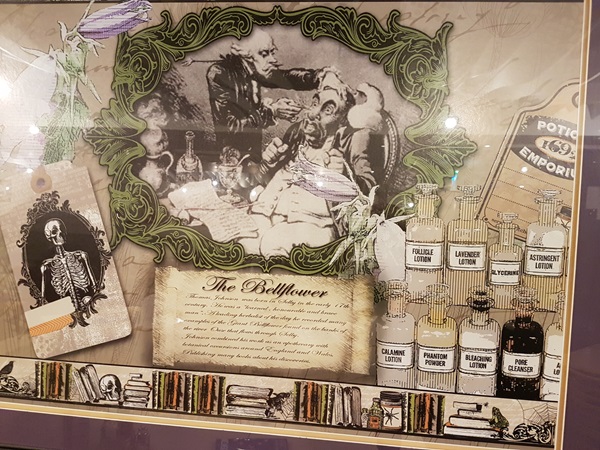
The text reads: Thomas Johnson was born in Selby in the early 17th century. He was a “learned, honourable and brave man”. A leading herbalist of the day he recorded many examples of the Giant Bellflower found on the banks of the river Ouse that flows through Selby.
Johnson combined his work as an apothecary with botanical excursions around England and Wales, publishing many books about his discoveries.
Text about the origins of Selby.
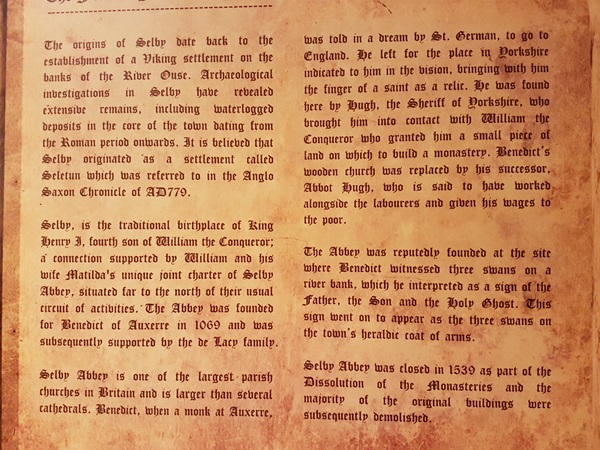
The text reads: The origins of Selby date back to the establishment of a Viking settlement on the banks of the river Ouse. Archaeological investigations in Selby have revealed extensive remains, including waterlogged deposits in the core of the town dating from the Roman period onwards. It is believed that Selby originated as a settlement called Seletun which was referred to in the Anglo Saxon Chronicle of AD779.
Selby is the traditional birthplace of King Henry I, fourth son of William the Conqueror; a connection supported by William and his wife Matilda’s unique joint charter of Selby Abbey, situated far to the north of their usual circuit of activities. The abbey was founded for Benedict of Auxerre in 1069 and was subsequently supported by the de Lacy family.
Selby Abbey is one of the largest parish churches in Britain and is larger than several cathedrals. Benedict, when a monk at Auxerre, was told in a dream by St. German, to go to England. He left for the place in Yorkshire indicated to him in the vision, bringing with him the finger of a saint as a relic. He was found here by Hugh, the Sheriff of Yorkshire, who brought him into contact with William the Conqueror who granted him a small piece of land on which to build a monastery. Benedict’s wooden church was replaced by his successor. Abbot Hugh, who is said to have worked alongside the labourers and given his wages to the poor.
The abbey was reputedly founded at the site where Benedict witnessed three swans on a river bank, which he interpreted as a sign of the Father, the Son and the Holy Ghost. This sign went on to appear as the three swans on the town’s heraldic coat of arms.
Selby Abbey was closed in 1539 as part of the Dissolution of the Monasteries and the majority of the original buildings were subsequently demolished.
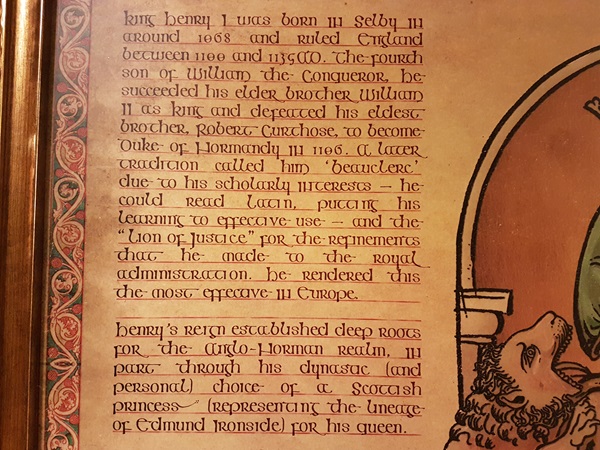
The text reads: King Henry I was born in Selby in around 1068 and ruled England between 1100 and 1135AD. The fourth son of William the Conqueror, he succeeded his elder brother William II as king and defeated his eldest brother Robert Curthose, to become Duke of Normandy in 1106. A later tradition called him ‘beauclerc’ due to his scholarly interests - he could read Latin, putting his learning to effective use – and the “Lion of Justice” for the refinements that he made to the royal administration. He rendered this the most effecave in Europe.
Henry’s reign established deep roots for the Anglo-Norman realm. In part through his dynasac (and personal) choice of a Scottish princess (representing the lineage of Edmund Ironside) for his Queen.
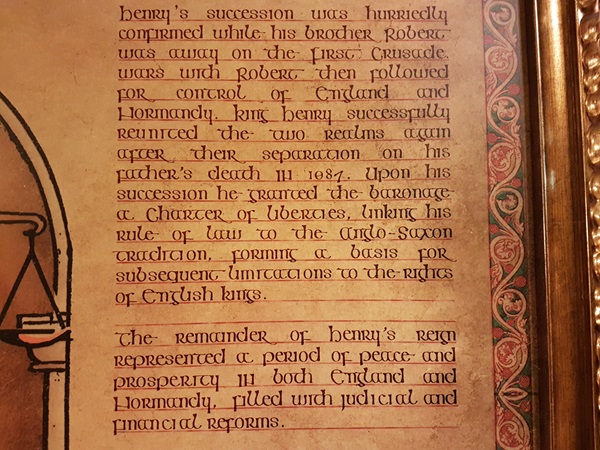
The text reads: Henry’s succession was hurriedly confirmed while his brother Robert was away on the First crusade. Wars with Robert then followed for control of England and Normandy. King Henry successfully returned the two realms again after their separation on his father’s death in 1087. Upon his succession he granted the baronage a charter of liberties, linking his rule of law to the Anglo-Saxon tradition, forming a basis for subsequent limitations to the rights of English Kings.
External photograph of the building – main entrance.
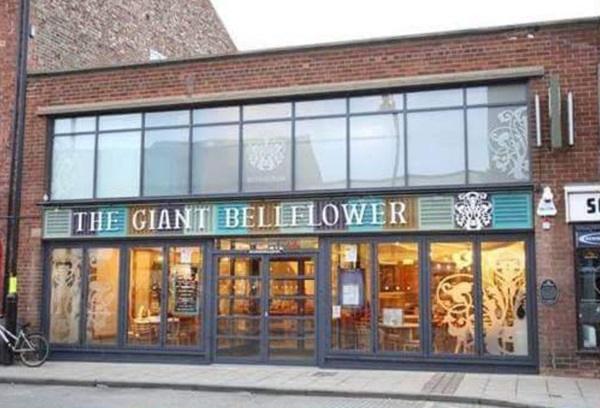
If you have information on the history of this pub, then we’d like you to share it with us. Please e-mail all information to: pubhistories@jdwetherspoon.co.uk